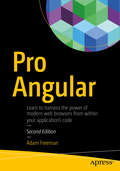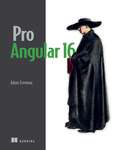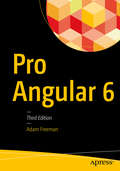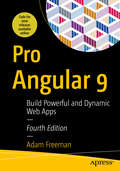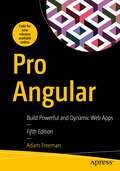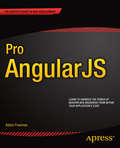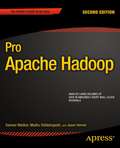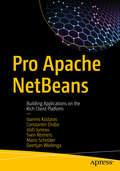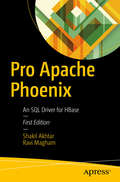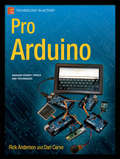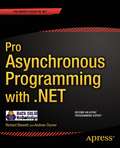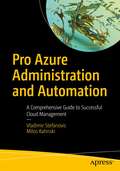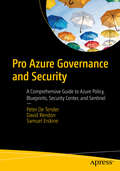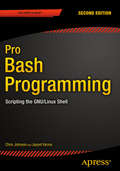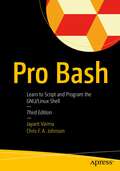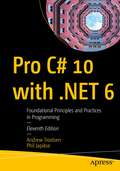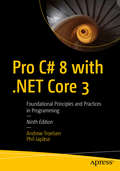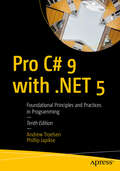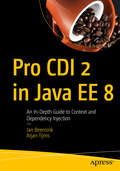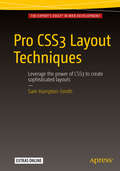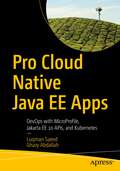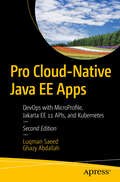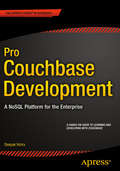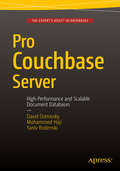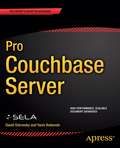- Table View
- List View
Pro Angular
by Adam FreemanGet the most from Angular 2, the leading framework for building dynamic JavaScript applications. Best-selling author Adam Freeman begins by describing the MVC pattern and the benefits it can offer and then shows you how to use Angular in your projects, starting from the nuts-and-bolts and building up to the most advanced and sophisticated features, going in-depth to give you the knowledge you need. Each topic is covered clearly and concisely and is packed with the details you need to learn to be truly effective. The most important features are given a no-nonsense in-depth treatment and chapters include common problems and details of how to avoid them. What you'll learn Gain a solid architectural understanding of the MVC Pattern Learn how to create rich and dynamic web app clients using Angular 2 Learn how to extend and customize Angular 2 Learn how to test your Angular 2 projects Who this book is for Web developers with a foundation knowledge of HTML and JavaScript who want to create rich client-side applications.
Pro Angular 16
by Adam FreemanGet Pro Angular 16, the most comprehensive guide to the Angular web framework available.Thousands of web developers have relied on Adam Freeman&’s Pro Angular series to get the most out of the Angular framework. Now in this revised sixth edition, Adam takes you from Angular&’s basic components to its most complex functions, highlighting common pitfalls and new features such as signals. In this thoroughly updated bestseller, you&’ll learn how to: Set up Angular dev tools and create projects Use features such as components, directives, services, and pipes Manage data changes with signals Navigate app features with URL routing Optimize Angular apps with pre-rendering and server-side rendering Use popular component libraries Pro Angular 16 gives you everything you need to build Angular apps that are easy to test, easy to maintain, and easy to extend and scale. You&’ll start with the basics—plus a refresher on HTML and TypeScript. You&’ll quickly move on to explore Angular&’s built-in functionalities and customization options, then dive into advanced features like asynchronous HTTP requests and component libraries. About the technology Angular is a powerful professional web framework suitable for building everything from lightweight prototypes to full-featured business applications. Created by Google and honed to perfection by millions of developers worldwide, Angular helps you deliver fast, predictable results when it counts. About the book Now in its sixth edition, Pro Angular 16 shows you the path to Angular mastery. This thoroughly revised book helps you build a toolbox of Angular skills, from directives and components to creating services and optimizing application delivery. Throughout, you&’ll use your skills to build a professional-level project—a SportStore e-commerce complete with checkout, administration, and deployment. Along the way, you&’ll pick up some great TypeScript techniques that will boost your web dev productivity. What's inside Set up Angular dev tools and create projects Manage data changes with signals Navigate app features with URL routing Use popular component libraries About the reader For web developers who know basic JavaScript and HTML. About the author Adam Freeman has written over fifty bestselling books on software development. He has held numerous senior IT positions, most recently as CTO and COO of a global bank. Table of Contents 1 Getting Ready PART 1: GETTING STARTED WITH ANGULAR 2 Jumping right in 3 Primer, Part 1 4 Primer, Part 2 5 SportsStore: a real application 6 SportsStore: orders and checkout 7 SportsStore: administration 8 SportsStore: deployment PART 2: ANGULAR IN DETAIL 9 Understanding Angular projects and tools 10 Angular reactivity and signals 11 Using Data Bindings 12 Using the built-in directives 13 Using events and forms 14 Creating attribute directives 15 Creating structural directives 16 Understanding components 17 Using and creating pipes 18 Using services 19 Using and creating modules PART 3: ADVANCED ANGULAR FEATURES 20 Creating the example project 21 Using the forms API, part 1 22 Using the forms API, part 2 23 Making HTTP Requests 24 Routing and navigation: part 1 25 Routing and navigation: part 2 26 Routing and navigation: part 3 27 Optimizing application delivery 28 Working with component libraries 29 Angular unit testing
Pro Angular 6
by Adam FreemanGet the most from Angular 6, the leading framework for building dynamic JavaScript applications. Understand the MVC pattern and the benefits it can offer.Best-selling author Adam Freeman shows you how to use Angular in your projects, starting from the nuts and bolts and building up to the most advanced and sophisticated features, going in-depth to give you the knowledge you need. Chapters include common problems and how to avoid them.What You’ll LearnGain a solid architectural understanding of the MVC PatternCreate rich and dynamic web app clients using Angular 6Use the ng tools to create and build an Angular projectExtend and customize Angular 6Test your Angular 6 projectsWhat's New in This EditionRevised for the features and changes in Angular 6Covers @angular/cli, ng command line tools, and WebPackIncludes HttpClient for simplified asynchronous HTTP requestsPresents updates to pipes and localized text displayWho This Book Is ForWeb developers with a foundation knowledge of HTML and JavaScript who want to create rich client-side applications
Pro Angular 9: Build Powerful and Dynamic Web Apps
by Adam FreemanWelcome to this one-stop-shop for learning Angular 9. Pro Angular 9 is the most concise and comprehensive guide available, giving you the knowledge you need to take full advantage of this popular framework for building your own dynamic JavaScript applications. The fourth edition of this popular guide explains how to get the most from Angular 9, starting with an in-depth overview of the MVC pattern and presenting the range of benefits it can offer. From there, you will begin learning how to use Angular in your projects, starting with the nuts-and-bolts concepts, and progressing on to more advanced and sophisticated features. Each topic in this full-color book provides you with precisely enough learning and detail to be effective. In true Adam Freeman style, the most important features are given full court press treatment, while also addressing common problems and how to avoid them. What You Will Learn:Gain a solid architectural understanding of the MVC PatternCreate rich and dynamic web app clients using Angular 9Use the ng tools to create and build an Angular projectExtend and customize AngularAcquire skills to unit test your Angular projectsWho This Book Is For:This book is for web developers who want to create rich client-side applications. Foundational knowledge of HTML and JavaScript is recommended."Adam's books provide a finely tuned blend of architectural overview, technical depth, and experience-born wisdom. His clear, concise writing style, coupled with project driven real world examples, make me comfortable recommending his books to a broad audience, ranging from developers working with a technology for the first time to seasoned professionals who need to learn a new skill quickly." Keith Dublin, Solution Principal, Slalom Consulting“Adam’s books are the print version of a chat bot. His investment in learning how developers learn pays off in dividends, making this one of the most comprehensive resources available. Novices and experienced professionals alike will gain knowledge from the accessible and insightful material.”Mark Donile, Software Engineer, MS CS
Pro Angular: Build Powerful and Dynamic Web Apps
by Adam FreemanWelcome to this one-stop shop for learning Angular. Pro Angular is the most concise and comprehensive guide available, giving you the knowledge you need to take full advantage of this popular framework for building your own dynamic JavaScript applications. Angular is an open-source JavaScript library maintained by Google. It has many excellent options when it comes to server-side development and is used in some of the largest and most complex web applications in the world to enhance HTML in the browser. Its cornerstone is the ability to create applications that are extendable, maintainable, testable, and standardized. Knowing Angular’s foundations and understanding its applications is an asset in any developer toolbox. The fifth edition of this popular guide explains how to get the most from Angular, presenting the range of benefits it can offer. You will begin learning how to use Angular in your projects, starting with the nuts-and-bolts concepts, and progressing to more advanced and sophisticated features. Each topic in this full-color book provides you with precisely enough learning and detail to be effective. In true Adam Freeman style, the most important features are given full-court press treatment, while also addressing common problems and how to avoid them.What You Will LearnAccess accompanying online files for Angular 13 and 14 (when it is released)Create rich and dynamic web app clients using AngularTap into some of the best aspects of server-side developmentKnow when to use Angular and when to seek an alternativeUse the ng tools to create and build an Angular projectExtend and customize AngularTake advantage of popular component librariesUtilize source code located at github.com/Apress/pro-angular-5edWho This Book Is ForThis book is for web developers who want to create rich client-side applications. Foundational knowledge of HTML and JavaScript is recommended."Adam's books provide a finely tuned blend of architectural overview, technical depth, and experience-born wisdom. His clear, concise writing style, coupled with project-driven, real-world examples make me comfortable recommending his books to a broad audience, ranging from developers working with a technology for the first time to seasoned professionals who need to learn a new skill quickly." Keith Dublin, Staff Architect, Upfront Health Care“Adam’s books are the print version of a chat bot. His investment in learning how developers learn pays off in dividends, making this one of the most comprehensive resources available. Novices and experienced professionals alike will gain knowledge from the accessible and insightful material.” Mark Donile, Software Engineer, MS CS
Pro AngularJS
by Adam FreemanAngularJS is the leading framework for building dynamic JavaScript applications that take advantage of the capabilities of modern browsers and devices. AngularJS, which is maintained by Google, brings the power of the Model-View-Controller (MVC) pattern to the client, providing the foundation for complex and rich web apps. It allows you to build applications that are smaller, faster, and with a lighter resource footprint than ever before. Best-selling author Adam Freeman explains how to get the most from AngularJS. He begins by describing the MVC pattern and the many benefits that can be gained from separating your logic and presentation code. He then shows how you can use AngularJS's features within in your projects to produce professional-quality results. Starting from the nuts-and-bolts and building up to the most advanced and sophisticated features AngularJS is carefully unwrapped, going in-depth to give you the knowledge you need. Each topic is covered clearly and concisely and is packed with the details you need to learn to be truly effective. The most important features are given a no-nonsense in-depth treatment and chapters include common problems and details of how to avoid them.
Pro Apache Hadoop
by Sameer Wadkar Madhu SiddalingaiahPro Apache Hadoop, Second Edition brings you up to speed on Hadoop - the framework of big data. Revised to cover Hadoop 2. 0, the book covers the very latest developments such as YARN (aka MapReduce 2. 0), new HDFS high-availability features, and increased scalability in the form of HDFS Federations. All the old content has been revised too, giving the latest on the ins and outs of MapReduce, cluster design, the Hadoop Distributed File System, and more. This book covers everything you need to build your first Hadoop cluster and begin analyzing and deriving value from your business and scientific data. Learn to solve big-data problems the MapReduce way, by breaking a big problem into chunks and creating small-scale solutions that can be flung across thousands upon thousands of nodes to analyze large data volumes in a short amount of wall-clock time. Learn how to let Hadoop take care of distributing and parallelizing your software--you just focus on the code; Hadoop takes care of the rest. Covers all that is new in Hadoop 2. 0 Written by a professional involved in Hadoop since day one Takes you quickly to the seasoned pro level on the hottest cloud-computing frameworkyy"
Pro Apache NetBeans: Building Applications on the Rich Client Platform
by Josh Juneau Geertjan Wielenga Ioannis Kostaras Constantin Drabo Sven Reimers Mario SchröderTake a detailed look at the NetBeans IDE and new features in the NetBeans Platform. Learn about support for JShell, the Jigsaw Module System, and Local Variable Type Inference, focusing on what this new version of NetBeans brings to developers who are working in Java and other supported languages. The book is a practical, hands-on guide providing a number of step-by-step recipes that help you take advantage of the power in the latest Java (and other) software platforms, and gives a good grounding on using NetBeans IDE for your projects. This book has been written by Apache community members who both use the IDE and actively contribute and develop Apache NetBeans as an open source project.Pro Apache NetBeans consists of three parts. The first part describes how to use the IDE as well as the new features that it brings to support the latest Java versions. The second part describes how you can extend NetBeans by creating plugins and writing your own applications using the Rich Client Platform. The third part describes how you can contribute to develop NetBeans IDE further, becoming part of the open source team that is driving future developments in the toolset. What You Will LearnWork faster and more effectively by applying expert tips and tricksApply NetBeans' most cutting-edge features to your Java developmentDebug your applications using intuitive features built into the IDEIdentify performance issues in your application by using the NetBeans profilerDevelop using the latest API of the NetBeans Rich Client PlatformExtend Apache NetBeans by creating plugins built on the Rich Client PlatformBuild NetBeans from source and understand the internals of NetBeans itselfContribute to the large community that supports and develops NetBeansWho This Book Is ForDevelopers who want to know the latest features in NetBeans, as well as how the transition to Apache has affected the future of the NetBeans IDE. The book is also of interest to those desiring to become contributors to the NetBeans project and to influence its future development. Java developers who need to create a new desktop application from scratch also will benefit from this book.
Pro Apache Phoenix
by Shakil Akhtar Ravi MaghamLeverage Phoenix as an ANSI SQL engine built on top of the highly distributed and scalable NoSQL framework HBase. Learn the basics and best practices that are being adopted in Phoenix to enable a high write and read throughput in a big data space. This book includes real-world cases such as Internet of Things devices that send continuous streams to Phoenix, and the book explains how key features such as joins, indexes, transactions, and functions help you understand the simple, flexible, and powerful API that Phoenix provides. Examples are provided using real-time data and data-driven businesses that show you how to collect, analyze, and act in seconds. Pro Apache Phoenix covers the nuances of setting up a distributed HBase cluster with Phoenix libraries, running performance benchmarks, configuring parameters for production scenarios, and viewing the results. The book also shows how Phoenix plays well with other key frameworks in the Hadoop ecosystem such as Apache Spark, Pig, Flume, and Sqoop. You will learn how to: Handle a petabyte data store by applying familiar SQL techniques Store, analyze, and manipulate data in a NoSQL Hadoop echo system with HBase Apply best practices while working with a scalable data store on Hadoop and HBase Integrate popular frameworks (Apache Spark, Pig, Flume) to simplify big data analysis Demonstrate real-time use cases and big data modeling techniques Who This Book Is For Data engineers, Big Data administrators, and architects.
Pro Arduino
by Rick Anderson Dan CervoSo, you've created a few projects with Arduino, and now it's time to kick it up a notch. Where do you go next? With Pro Arduino, you'll learn about new tools, techniques, and frameworks to make even more ground-breaking, eye-popping projects. You'll discover how to make Arduino-based gadgets and robots interact with your mobile phone. You'll learn all about the changes in Arduino 1.0, you'll create amazing output with openFrameworks, and you'll learn how to make games with the Gameduino. You'll also learn advanced topics, such as modifying the Arduino to work with non-standard Atmel chips and Microchip's PIC32. Rick Anderson, an experienced Arduino developer and instructor, and Dan Cervo, an experienced Arduino gadgeteer, will give you a guided tour of advanced Arduino capabilities. If it can be done with an Arduino, you'll learn about it here.
Pro Asynchronous Programming with .NET
by Richard Blewett Andrew ClymerPro Asynchronous Programming with . NET teaches the essential skill of asynchronous programming in . NET. It answers critical questions in . NET application development, such as: how do I keep my program responding at all times to keep my users happy? how do I make the most of the available hardware? how can I improve performance?In the modern world, users expect more and more from their applications and devices, and multi-core hardware has the potential to provide it. But it takes carefully crafted code to turn that potential into responsive, scalable applications. With Pro Asynchronous Programming with . NET you will: Meet the underlying model for asynchrony on Windows--threads. Learn how to perform long blocking operations away from your UI thread to keep your UI responsive, then weave the results back in as seamlessly as possible. Master the async/await model of asynchrony in . NET, which makes asynchronous programming simpler and more achievable than ever before. Solve common problems in parallel programming with modern async techniques. Get under the hood of your asynchronous code with debugging techniques and insights from Visual Studio and beyond. In the past asynchronous programming was seen as an advanced skill. It's now a must for all modern developers. Pro Asynchronous Programming with . NET is your practical guide to using this important programming skill anywhere on the . NET platform.
Pro Azure Administration and Automation: A Comprehensive Guide to Successful Cloud Management
by Vladimir Stefanovic Milos KatinskiLearn best practices and the proper use of Azure management tools, such as Azure Portal, Azure PowerShell, Azure CLI, and ARM templates, which are time-saving tools that support daily administration tasks such as monitoring, alerting, backups, security, and more. This book explores common Azure services, including Azure networking, virtual machines, app services, backup, monitoring, and other tools of the trade that IT professionals use on a regular basis. And you will come away with a strong understanding of these services and how to use them.While Microsoft Azure is no longer “the new cloud on the block,” it continues to be one of the fastest-growing platforms with regard to features, integrations, and capabilities. Over the last decade, it has undergone significant changes and amassed a large following, but many of its users, especially those who transitioned from traditional admin tasks to modern cloud computing, are not reaping its full benefits.Management in the cloud, while seemingly simpler in some ways, is not without its own set of complexities and headaches. Admins want to streamline it where it makes sense and allocate the right resources to the right job in order to keeps cost in check, but where does one begin? Pro Azure Administration and Automation is a comprehensive guide that is chock full of time-saving recipes and scripts you can rely on to learn about day-to-day Azure administration and automation. What You Will Learn Attain theoretical and practical knowledge on deploying and managing AzureGain an understanding of services, their relationship with other services, and their configuration parametersAdopt a modern mindset, transitioning from a traditional IT admin mindset to a cloud admin proUnderstand how everything in the cloud is billable and learn how to factor it into choicesApply in-chapter PowerShell scripts and ARM templates which can be re-purposedKnow when it makes sense to be more involved in tasks (for example, automation and scripting) Who This Book Is For IT professionals who are responsible for the day-to-day tasks in Azure as well as cloud management and planning
Pro Azure Governance and Security: A Comprehensive Guide to Azure Policy, Blueprints, Security Center, and Sentinel
by Samuel Erskine Peter De Tender David RendonAny IT professional can tell you that managing security is a top priority and even more so when working in the cloud. Access to accurate and timely security information is critical, but governance and control must first be enabled. This guide shows you how to take advantage of Azure's vast and powerful built-in security tools and capabilities for your application workloads.Pro Azure Governance and Security offers a comprehensive look at the governance features available with Microsoft Azure and demonstrates how to integrate them with your hybrid and Azure environments, drawing on the author's experiences from years in the field. Learn about the array of controls implemented within Microsoft Azure from two valuable perspectives: the customer and Microsoft operations. Beginning with the top-level subscription hierarchy, learn about the most important built-in Azure security services and features, as well as how to use Azure Policies and Blueprints as a means for security and governance. A series of hands-on exercises teaches you the concepts of Azure Governance: how to enable and deploy Azure Security Center, integrate RBAC (role-based access control), and set up Azure Operations and Monitoring. Get introduced to the new Azure Sentinel solution that offers SIEM as a service for security incident management and proactive hunting.What You'll Learn Understand different architectural designs for implementing Azure SecurityOperate and monitor an Azure environmentDeploy Azure Governance, Policies, and BlueprintsDiscover key Azure features that enhance securityImplement and confidently access Azure Security CenterGet to know Azure Sentinel Who This Book Is ForTechnical engineers, consultants, solution and cloud architects, IT managers, and SecOps teams who need to understand how to integrate governance, security, and compliance in hybrid and Azure environments. A basic understanding of Azure or other public cloud platforms is beneficial, but not required.
Pro Bash Programming
by Jayant Varma Chris F. A. JohnsonThe bash shell is a complete programming language, not merely a glue to combine external Linux commands. By taking full advantage of shell internals, shell programs can perform as snappily as utilities written in C or other compiled languages. And you will see how, without assuming Unix lore, you can write professional bash 4. 0 programs through standard programming techniques. Complete bash coverage Teaches bash as a programming language Helps you master bash 4. 0 features What you'll learn Use the shell to write new utilities and accomplish most programming tasks. Use shell parameter expansion to replace many external commands, making scripts very fast. Learn to avoid many common mistakes that cause scripts to fail. Learn how bash's readline and history libraries can save typing when getting user input. Learn to use features new to bash 4. 0. Build shell scripts that get information from the Web. Who this book is for Beginning Linux and Unix system administrators who want to be in full command of their systems. Table of Contents Hello, World! Your First Shell Program Input, Output, and Throughput Looping and Branching Command-Line Parsing and Expansion Parameters and Variables Shell Functions String Manipulation File Operations and Commands Reserved Words and Builtin Commands Writing Bug-Free Scripts and Debugging the Rest Programming for the Command Line Runtime Configuration Data Processing Scripting the Screen Entry-Level Programming
Pro Bash: Learn to Script and Program the GNU/Linux Shell
by Jayant VarmaLearn how to effectively utilize the Bash shell in your programming. This refreshed and expanded third edition has been updated to Bash 5.2, and many scripts have been rewritten to make them more idiomatically Bash, taking better advantage of features specific to Bash. It is easy to read, understand, and will teach you how to get to grips with Bash programming without drowning you in pages and pages of syntax.Using this book you will be able to use the shell efficiently, make scripts run faster using expansion and external commands, and understand how to overcome many common mistakes that cause scripts to fail. This book is perfect for all beginning Linux and Unix system administrators who want to be in full control of their systems, and really get to grips with Bash programming.The Bash shell is a complete programming language, not merely a glue to combine external Linux commands. By taking full advantage of Shell internals, Shell programs can perform as snappily as utilities written in C or other compiled languages. And you will see how, without assuming UNIX lore, you can write professional Bash programs through standard programming techniques.What You'll Learn Use the Bash shell to write utilities and accomplish most programming tasksReplace many external commands with shell parameter expansion making scripts very fastAvoid many common mistakes that cause scripts to failSee how Bash’s read line and history libraries can save typing when getting user inputBuild shell scripts that get information from the WebWho This Book Is ForDevelopers, programmers, and open source enthusiasts who want to write scripts using Bash on multiple platforms
Pro C# 10 with .NET 6: Foundational Principles and Practices in Programming
by Andrew Troelsen Phil JapikseWelcome to the most comprehensive foundational guide available on the topic of C# coding and .NET. This book goes beyond “do this, to achieve this” to drill down into the core stuff that makes a good developer, great. This expanded 11th edition delivers loads of new content on Entity Framework, Razor Pages, Web APIs and more. You will find the latest C# 10 and .NET 6 features served up with plenty of “behind the curtain” discussion designed to expand developers’ critical thinking skills when it comes to their craft. Coverage of ASP.NET Core, Entity Framework Core, and more sits alongside the latest updates to the new unified .NET platform, from performance improvements to Windows Desktop apps on .NET 6, updates in XAML tooling, and expanded coverage of data files and data handling. Going beyond the latest features in C# 10, all code samples are rewritten for this latest release. Dive in and discover why this essential classic is a favorite of C# developers worldwide. Gain a solid foundation in object-oriented development techniques, attributes and reflection, generics and collections, and numerous advanced topics not found in other texts (such as CIL opcodes and emitting dynamic assemblies). Pro C# 10 with .NET 6 will build your coding confidence putting C# into practice, and exploring the .NET universe and its vast potential on your own terms.What You Will LearnExplore C# 10 features and updates in records and record structs, global and implicit using directives, file level namespaces, extended property patterns, and moreDevelop applications with C# and modern frameworks for services, web, and smart client applicationsHit the ground running with ASP.NET Core web applications using MVC and Razor Pages, including view components, custom tag helpers, custom validation, GDPR support, and areasBuild ASP.NET RESTful services complete with versioning, enhanced swagger, and basic authenticationEmbrace Entity Framework Core for building real-world, data-centric applications, with deeply expanded coverage new to this edition including SQL Server temporal table supportDive into Windows Desktop Apps on .NET 6 using Windows Presentation FoundationUnderstand the philosophy behind .NETDiscover the new features in .NET 6, including single file applications, smaller container images, and more Who This Book Is ForDevelopers of any level who want to either learn C# and .NET or want to take their skills to the next level.“Amazing! Provides easy-to-follow explanations and examples. I remember reading the first version of this book; this is a ‘must-have’ for your collection if you are learning .NET!” – Rick McGuire, Senior Application Development Manager, Microsoft“Phil is a journeyman programmer who brings years of experience and a passion for teaching to make this fully revised and modernized ‘classic’ a ‘must-have’. Any developer who wants full-spectrum, up-to-date coverage of both the C# language and how to use it with .NET and ASP.NET Core should get this book.”– Brian A. Randell, Partner, MCW Technologies and Microsoft MVP
Pro C# 8 with .NET Core 3: Foundational Principles and Practices in Programming
by Andrew Troelsen Phil JapikseThis essential classic provides a comprehensive foundation in the C# programming language and the frameworks it lives in. Now in its 9th edition, you will find the latest C# 8 and .NET Core features, along with new chapters on Microsoft’s lightweight, cross-platform framework, .NET Core 3.1. Coverage of ASP.NET Core, Entity Framework Core, and more, sits alongside the latest updates to .NET Core, including Windows Presentation Foundation (WPF). Not only does this book cover all of the latest features in C# 8, but all chapters and code samples have been rewritten for this latest release.Dive in and discover why this book has been a favorite of C# developers worldwide for more than 15 years. Gain a solid foundation in object-oriented development techniques, attributes and reflection, generics and collections, and numerous advanced topics not found in other texts (such as CIL opcodes and emitting dynamic assemblies). With the help of Pro C# 8 with .NET Core 3 gain the confidence to put C# into practice and explore the .NET Core universe on your own terms.What You Will LearnDiscover the bells and whistles of C# 8 features and updates to previous featuresHit the ground running with ASP.NET Core web applications and web services, and Entity Framework CoreWork with the latest version of Windows Presentation Foundation, now a part of .NET CoreUnderstand the philosophy behind .NET and the cross-platform alternative, .NET CoreDevelop applications with C# and modern frameworks for services, web, and smart client applicationsWho This Book Is ForDevelopers who are interested in .NET programming and the C# language“Amazing! Provides easy-to-follow explanations and examples. I remember reading the first version of this book; this is a 'must-have' for your collection if you are learning .NET Core!” – Rick McGuire, Senior Application Development Manager, Microsoft “Phil is a journeyman programmer who brings years of experience and a passion for teaching to make this fully revised and modernized ‘classic’ a ‘must-have’. Any developer who wants full-spectrum, up-to-date coverage of both the C# language and how to use it with .NET Core and ASP.NET Core should get this book.”– Brian A. Randell, Partner, MCW Technologies and Microsoft MVP
Pro C# 9 with .NET 5: Foundational Principles and Practices in Programming
by Andrew Troelsen Phillip JapikseThis essential classic provides a comprehensive foundation in the C# programming language and the framework it lives in. Now in its 10th edition, you will find the latest C# 9 and .NET 5 features served up with plenty of "behind the curtain" discussion designed to expand developers’ critical thinking skills when it comes to their craft. Coverage of ASP.NET Core, Entity Framework Core, and more, sits alongside the latest updates to the new unified .NET platform, from performance improvements to Windows Desktop apps on .NET 5, updates in XAML tooling, and expanded coverage of data files and data handling. Going beyond the latest features in C# 9, all code samples are rewritten for this latest release. Dive in and discover why this book is a favorite of C# developers worldwide. Gain a solid foundation in object-oriented development techniques, attributes and reflection, generics and collections, and numerous advanced topics not found in other texts (such as CIL opcodes and emitting dynamic assemblies). With the help of Pro C# 9 with .NET 5 you will gain the confidence to put C# into practice, and explore the .NET universe and its vast potential on your own terms. What You Will Learn Explore C# 9 features and updates in records, immutable classes, init only setters, top-level statements, patterns, and moreHit the ground running with ASP.NET Core web applications and web servicesEmbrace Entity Framework Core for building real-world, data-centric applications, with deeply expanded coverage new to this editionDevelop applications with C# and modern frameworks for services, web, and smart client applicationsUnderstand the philosophy behind .NET Discover the new features in .NET 5, including single file applications and smaller container images, Windows ARM64 support, and more Dive into Windows Desktop Apps on .NET 5 using Windows Presentation Foundation Check out performance improvements included with updates to ASP.NET Core, Entity Framework Core, and internals like garbage collection, System.Text.Json, and container size optimization Who This Book Is For Developers who are interested in .NET programming and the C# language “Amazing! Provides easy-to-follow explanations and examples. I remember reading the first version of this book; this is a ‘must-have’ for your collection if you are learning .NET!” – Rick McGuire, Senior Application Development Manager, Microsoft “Phil is a journeyman programmer who brings years of experience and a passion for teaching to make this fully revised and modernized ‘classic’ a ‘must-have’. Any developer who wants full-spectrum, up-to-date coverage of both the C# language and how to use it with .NET and ASP.NET Core should get this book.” – Brian A. Randell, Partner, MCW Technologies and Microsoft MVP
Pro CDI 2 in Java EE 8: An In-Depth Guide to Context and Dependency Injection
by Arjan Tijms Jan BeerninkIn Pro CDI 2 in Java EE 8, use CDI and the CDI 2.0 to automatically manage the life cycle of your enterprise Java, Java EE, or Jakarta EE application’s beans using predefined scopes and define custom life cycles using scopes. In this book, you will see how you can implement dynamic and asynchronous communication between separate beans in your application with CDI events. The authors explain how to add new capabilities to the CDI platform by implementing these capabilities as extensions. They show you how to use CDI in a Java SE environment with the new CDI initialization and configuration API, and how to dynamically modify the configuration of beans at application startup by using dynamic bean building.This book is compatible with the new open source Eclipse Jakarta EE platform and tools.What You Will LearnUse qualifier annotations to inject specific bean implementationsProgrammatically retrieve bean instances from the CDI container in both Java SE and Java EE when injecting them into an object isn’t possible Dynamically replace beans using the @Alternative annotation to, for example, replace a bean with a mock version for testing Work with annotation literals to get instances of annotations to use with the CDI APIDiscover how scopes and events interactWho This Book Is ForThose who have some experience with CDI, but may not have experience with some of the more advanced features in CDI.
Pro CSS3 Layout Techniques
by Sam Hampton-SmithThis books demonstrates the freshest cutting-edge layout tools found within CSS3, teaching you the skills you'll need to create advanced design patterns for websites and apps. Pro CSS3 Layout Techniques teaches you how to make the most of CSS3's existing specification, including those parts of the specification already widely implemented, as well as the upcoming modules that are still being developed by the W3C. After reading this book you'll be able to confidently develop sophisticated, flexible layouts that aren't possible with CSS2. 1. CSS1 allowed designers to separate content from presentation for the first time and CSS2 cemented support for advanced typographical control, but neither specification provided more than rudimentary layout control. CSS3's latest additions allow designers to craft fully responsive, sophisticated layouts without the need for complex scripts or smoke-and-mirror workarounds. CSS3 is still in active development, with browser vendors racing against each other to implement the latest recommendations from the W3C. Pro CSS3 Layout Techniques will help you cut through the waffle and get straight to the heart of what works now, while showing you how to be ready for the future of CSS! What you'll learn * Teaches cutting-edge techniques for CSS3 layout * Covers all major CSS3 layout modules including multi-column, regions, and grid * Includes detailed coverage and examples of the new, powerful FlexBox * Features beta information on edge-modules in development * Covers use of libraries, frameworks and polyfills Who this book is for Pro CSS3 Layout Techniques is aimed at the web designer who yearns for the power and flexibility of print-layout tools, while keenly supporting the Responsive Web Design (RWD) approach to developing content that works across all devices. The book deals with a fundamental element of website design, but covers material many web professionals will be unaware of, making it an ideal purchase for all but the most technically sophisticated of web designers and developers. The book uses a tutorial-led approach to demonstrate real-world examples of new techniques, while providing an accessible reference guide for subsequent referral.
Pro Cloud Native Java EE Apps: DevOps with MicroProfile, Jakarta EE 10 APIs, and Kubernetes
by Luqman Saeed Ghazy AbdallahThis professional guide to Java-based cloud native apps DevOps dives deeper into building and deploying production ready cloud native apps using the increasingly popular open source Eclipse MicroProfile framework, Jakarta EE 10 APIs and the most popular Kubernetes container orchestration tool.After a quick overview of Jakarta EE and MicroProfile, Pro Cloud Native Java EE Apps starts you on your way by walking you through a cloud-native Jakarta EE-based application case study that will be forged piece-by-piece over the course of the book. Next, you'll interject dependencies and data persistence capabilities as microservices to go with the case study app that you are building. Next, you'll employ the REST API using Jakarta REST APIs and the MicroProfile RESTClient. You'll also explore ways to add resilience to your app, keep count with metrics, check on your app's health, secure your app, and test and complete your production-ready cloud-native app. Finally, you'll dive into migrating a monolith to become a production ready cloud-native app. After reading this book, you'll be able to build your own production ready cloud-native Java app using Jakarta EE and MicroProfile. What You Will LearnBuild and deploy a production-ready cloud-native Java app using MicroProfile, Jakarta EE and KubernetesMigrate a monolith app to become a cloud-native appEmploy Jakarta EE APIs such as Persistence, CDI and moreLeverage the MicroProfile frameworkExplore configurations, resilience, metrics, health, security, and more for your cloud-native appsWho This Book Is ForThose software developers and programmers with at least some prior experience using Jakarta EE, MicroProfile. At least some prrior Java experience is expected.
Pro Cloud-Native Java EE Apps: DevOps with MicroProfile, Jakarta EE 11 APIs, and Kubernetes
by Luqman Saeed Ghazy AbdallahLearn how to build and deploy Java-based cloud native apps with Jakarta EE with the MicroProfile framework and Kubernetes. This revamped Second Edition reflects the latest updates in Jakarta EE 11, including enhanced support for creating web APIs with Jakarta REST, concurrency management with Jakarta Concurrency, and data persistence with Jakarta Persistence, while incorporating key changes introduced by MicroProfile 7.0. After a quick overview of Jakarta EE and MicroProfile, Pro Cloud Native Java EE Apps starts you on your way by walking you through a cloud-native Jakarta EE-based application case study that will be forged piece-by-piece over the course of the book. Next, you'll interject dependencies and data persistence capabilities as microservices to go with the case study app that you are building. Then, you will dive into migrating a monolith to become a production-ready cloud-native app. Finally, you will look ahead to the future of Jakarta EE with a NEW chapter on artificial intelligence and large language models, exploring potential use cases for how AI-integration can enhance Jakarta EE capabilities. This revised new edition ensures you are equipped with the most current tools and techniques to develop forward-looking, cloud-native apps. What You Will Learn ● Build and deploy a production-ready cloud-native Java app using MicroProfile, Jakarta EE and Kubernetes ● Migrate a monolith app to become a cloud-native app ● Employ Jakarta EE APIs such as Persistence, CDI and more ●<span style="font: 7.0pt '
Pro Couchbase Development
by Deepak VohraPro Couchbase Development: A NoSQL Platform for the Enterprise discusses programming for Couchbase using Java and scripting languages, querying and searching, handling migration, and integrating Couchbase with Hadoop, HDFS, and JSON. It also discusses migration from other NoSQL databases like MongoDB. This book is for big data developers who use Couchbase NoSQL database or want to use Couchbase for their web applications as well as for those migrating from other NoSQL databases like MongoDB and Cassandra. For example, a reason to migrate from Cassandra is that it is not based on the JSON document model with support for a flexible schema without having to define columns and supercolumns. The target audience is largely Java developers but the book also supports PHP and Ruby developers who want to learn about Couchbase. The author supplies examples in Java, PHP, Ruby, and JavaScript. After reading and using this hands-on guide for developing with Couchbase, you'll be able to build complex enterprise, database and cloud applications that leverage this powerful platform. What you'll learn What has big data got to do with NoSQL and Couchbase Server? How to program with Java for Couchbase How to develop with Couchbase using scripting languages including JavaScript, PHP and Ruby How to query and search using the Couchbase plug-in for elasticsearch, NIQL, Strings and more How to handle migration paths like MongoDB to Couchbase, Cassandra to Couchbase, Oracle DB and Tables to Couchbase and more How to integrate Couchbase with Hadoop, Hadoop Tables, HDFS, and JSON Who this book is for This book is for experienced Java and other programmers who have at least some experience with database enterprise development who want to learn how to develop with Couchbase. Table of Contents Section 1. Introduction 1. Why NoSQL? Section II. Java Clients 2. Using the Java Client with Couchbase Server in Eclipse IDE 3. Using Spring Data with Couchbase Server in Eclipse IDE Section III: Scripting Languages 4. Accessing Couchbase Server with PHP 5. Accessing Couchbase Server with Ruby 6. Using Node. js with Couchbase Server Section IV: Query and Search 7. Using the Couchbase Plugin for Elasticsearch 8. Querying Couchbase with NIQL Section V: Migration 9. Migrating MongoDB NoSQL Database to Couchbase 10. Migrating Cassandra Database to Couchbase 11. Migrating Oracle Database to Couchbase Section VI: Hadoop 12. Using Couchbase Hadoop Connector
Pro Couchbase Server
by David Ostrovsky Mohammed Haji Yaniv RodenskiThis new edition is a hands-on guide for developers and administrators who want to use the power and flexibility of Couchbase Server 4. 0 in their applications. The second edition extends coverage of N1QL, the SQL-like query language for Couchbase. It also brings coverage of multiple new features, including the new generation of client SDKs, security and LDAP integration, secondary indexes, and multi-dimensional scaling. Pro Couchbase Server covers everything you need to develop Couchbase solutions and deploy them in production. The NoSQL movement has fundamentally changed the database world in recent years. Influenced by the growing needs of web-scale applications, NoSQL databases such as Couchbase Server provide new approaches to scalability, reliability, and performance. Never have document databases been so powerful and performant. With the power and flexibility of Couchbase Server, you can model your data however you want, and easily change the data model any time you want. Pro Couchbase Server shows what is possible and helps you take full advantage of Couchbase Server and all the performance and scalability that it offers. Helps you design and develop a document database using Couchbase Server. Covers the latest features such as the N1QL query language. Gives you the tools to scale out your application as needed. What you'll learn Install and configure Couchbase Server Design a good data model for your application. Build mobile applications on the Xamarin platform. Deploy advanced query techniques in your application. Make use of the new and powerful N1 Query Language. Integrate Elastic Search for full-text access to your data. Manage Couchbase Server in a production environment. Scale your application as needed. Who this book is for Pro Couchbase Server is a comprehensive guide for developers looking to build scalable, high-performance application solutions. Written from hands-on experience, the book also provides detailed information for administrators on deploying, maintaining, and scaling out of Couchbase Server. Whether you want to build an application from scratch or migrate an existing application to a document database, Pro Couchbase Server has your back with solid guidance written from experienced practitioners who have experienced repeated success in deploying Couchbase Server in production environments. Table of Contents Introduction Part I: Getting Started Chapter 1: Getting Started with Couchbase Server Chapter 2: Designing Document-Oriented Databases with Couchbase Part II: Development Chapter 3: The Couchbase Client Libraries Chapter 4: CRUD and Key-Based Operations Chapter 5: Working with Views Chapter 6: The N1QL Query Language Chapter 7: Advanced Couchbase Techniques Chapter 8: ElasticSearch Integration Part III: Under the Hood Chapter 9: Security Chapter 10: Secondary Indexes Part IV: Couchbase at Scale Chapter 11: Sizing and Deployment Considerations Chapter 12: Basic Administration Chapter 13: Monitoring and Best Practices Chapter 14: Couchbase Server in the Cloud Chapter 15: Cross-Datacenter Replication Part V: Mobile Development with Couchbase Chapter 16: Couchbase Lite on Android
Pro Couchbase Server
by David Ostrovsky Yaniv RodenskiPro Couchbase Server is a hands-on guide for developers and administrators who want to take advantage of the power and scalability of Couchbase Server in their applications. This book takes you from the basics of NoSQL database design, through application development, to Couchbase Server administration. Never have document databases been so powerful and performant. yThe NoSQL movement has fundamentally changed the database world in recent years. Influenced by the growing needs of web-scale applications, NoSQL databases such as Couchbase Server provide new approaches to scalability, reliability, and performance. With the power and flexibility of Couchbase Server, you can model your data however you want, and easily change the data model any time you want. Pro Couchbase Server shows what is possible and helps you take full advantage of Couchbase Server and all the performance and scalability that it offers. y Helps you design and develop a document database using Couchbase Server. Takes you through deploying and maintaining Couchbase Server. Gives you the tools to scale out your application as needed. "
